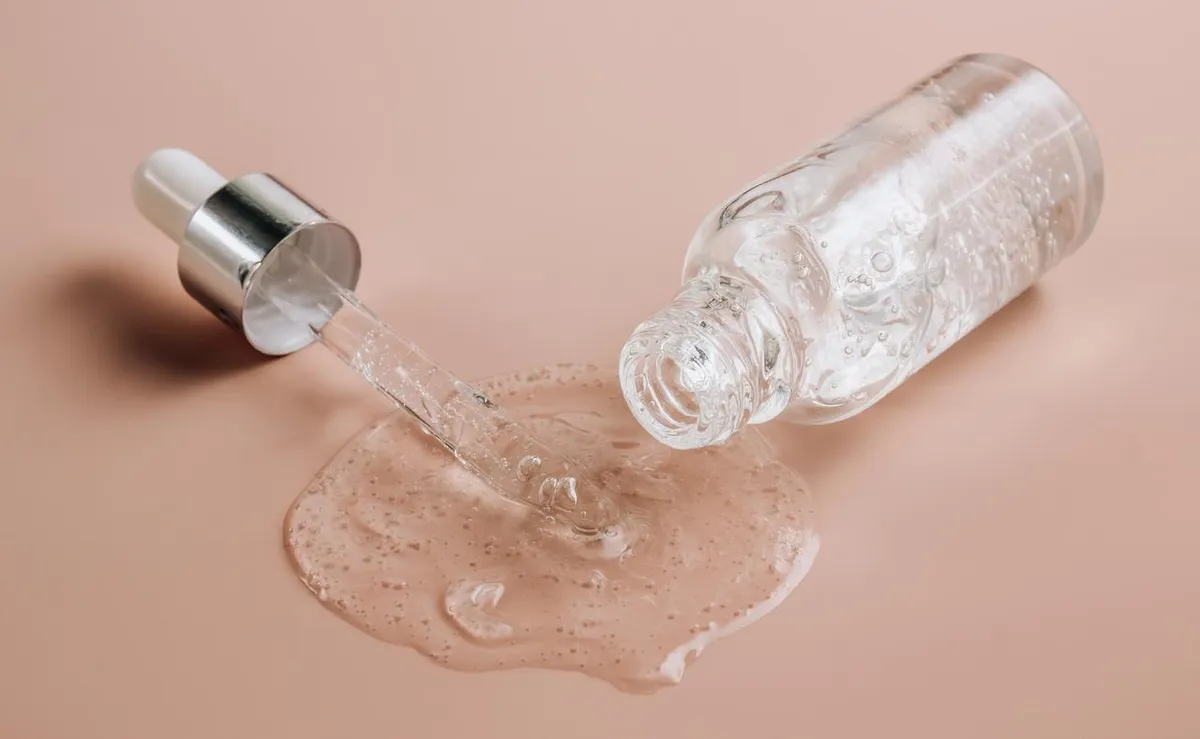
Are you tired of dry, aging skin that loses its youthful glow? Hyaluronic acid is a powerhouse ingredient renowned for keeping skin plump and hydrated. In this ultimate guide, we'll dive into how it can benefit your skin, soothe joint pain, and even speed up healing.
Discover the secret to supple skin!
Key Takeaways
- Hyaluronic acid is a natural substance that helps keep skin moist and joints lubricated.
- It fights aging by reducing wrinkles and promotes healing in wounds.
- Taking hyaluronic acid can ease joint pain, especially from arthritis.
- Side effects are rare but can include redness and swelling at injection sites or allergies.
- Applying it to the skin or taking supplements can improve skin health and joint function.
What is Hyaluronic Acid?
Hyaluronic acid is a natural substance found in the human body that has a unique ability to retain moisture and keep tissues well lubricated. It plays a crucial role in skin health, joint function, and connective tissue support.
Chemistry and properties
Hyaluronic acid is a clear, gooey substance naturally produced by your body. Its main function is to keep tissues wet and well lubricated. As a large molecule or polysaccharide, it belongs to the glycosaminoglycan family due to its repeated sugars called disaccharides.
This molecule can hold up to 1,000 times its weight in water, which makes it excellent for moisture retention in the skin. It binds with water tightly, creating a viscous fluid that gives skin hydration and volume.
This unique property benefits connective tissue health as well, including joint support by acting as a cushioning agent.
Biosynthesis and degradation
Hyaluronic acid is produced naturally in the body, primarily in the connective tissues and eyes. Enzymes within the cells synthesize hyaluronic acid by stringing together sugar molecules.
Tissue growth and repair drive its biosynthesis, ensuring continual renewal and maintenance of skin, joint, and eye health. Conversely, degradation occurs as part of a natural process to remove old or damaged hyaluronic acid molecules from the body.
This breakdown is facilitated by enzymes that chop up hyaluronic acid into smaller fragments for removal through normal bodily functions.
The production of hyaluronic acid takes place within various cell types including fibroblasts, keratinocytes, and chondrocytes. The synthesized hyaluronic acid contributes to tissue hydration, lubrication of joints, wound healing processes, among other vital roles such as maintaining skin elasticity and moisture content.
Tissue and cell distribution
Hyaluronic acid is found in various tissues and organs throughout the body, including the skin, eyes, and connective tissues. It plays a crucial role in maintaining hydration and lubrication in these areas, contributing to skin moisture and joint lubrication.
In the skin, hyaluronic acid is distributed within the epidermis and dermis, where it helps to keep the skin hydrated and maintain its elasticity. Within the eyes, it is present in the vitreous humor of the eyeball, providing support and maintaining shape.
Furthermore, hyaluronic acid is abundant in synovial fluid within joints, where it acts as a lubricant for smooth joint movement.
The distribution of hyaluronic acid also extends to other key areas such as cartilage and blood vessels. It serves as an essential component of cartilage, contributing to its cushioning properties that protect joints during movement.
Benefits and Uses
Hyaluronic acid can be used for anti-aging purposes by reducing the appearance of fine lines and wrinkles. It is also effective in wound healing and providing relief from joint pain.
Anti-aging
Hyaluronic acid has gained popularity for its anti-aging benefits, effectively reducing fine lines and wrinkles. Its ability to retain moisture helps plump the skin, diminishing the appearance of wrinkles and promoting a more youthful complexion.
Hyaluronic acid stimulates collagen production, which improves skin elasticity and firmness, contributing to a more youthful appearance.
Supplementing hyaluronic acid can combat skin aging by improving hydration levels and reducing the visibility of fine lines. The increased moisture retention provided by hyaluronic acid promotes smoother, softer skin with improved texture.
Wound healing
Hyaluronic acid stimulates wound healing by promoting tissue repair and reducing inflammation. Its ability to hold moisture aids in creating an optimal environment for the skin to heal.
It also plays a role in regulating inflammation, which is crucial for the different phases of wound healing. Studies show that hyaluronic acid accelerates wound closure and reduces scarring due to its moisturizing and anti-inflammatory properties, making it beneficial for various skin injuries.
The application of hyaluronic acid in wound care has shown promising results in accelerating the healing process without adverse effects on the surrounding tissues. This natural substance supports cell migration and proliferation, critical aspects of tissue regeneration.
Joint pain relief
Hyaluronic acid supplements can help provide relief for joint pain, particularly in individuals with osteoarthritis. The natural lubricating properties of hyaluronic acid aid in reducing joint discomfort and improving mobility.
Research suggests that hyaluronic acid injections directly into the joint cavity may alleviate pain and stiffness caused by various joint conditions, making it a promising option for those seeking alternative treatments for joint pain relief.
Effectiveness and Side Effects
Hyaluronic acid has been shown to be effective in topical treatments for wrinkle reduction and anti-aging, but potential risks and side effects should also be considered. To learn more about its benefits, uses, and possible side effects, keep reading!
Is it effective?
Hyaluronic acid is effective in moisturizing and hydrating the skin, reducing the appearance of wrinkles, and promoting skin elasticity. It also aids in speeding up wound healing and relieving joint pain associated with conditions like arthritis.
When used topically or taken as a supplement, hyaluronic acid has shown to have positive effects on maintaining skin health and improving joint mobility. Additionally, it can address various skin concerns such as eczema and facial redness.
With its ability to retain moisture, hyaluronic acid demonstrates effectiveness in providing hydration for the skin, keeping it supple and youthful.
The topical treatments containing hyaluronic acid are effective in reducing wrinkle formation by plumping up the skin from within. These treatments contribute to anti-aging benefits by enhancing overall skin quality, leading to a more youthful appearance.
Potential risks and side effects
- Hyaluronic acid injections may cause temporary side effects such as redness, pain, itching, and swelling at the injection site.
- In rare cases, hyaluronic acid may lead to allergic reactions, including hives, itching, and difficulty breathing.
- Incorrect administration of hyaluronic acid injections can result in lumps or bumps under the skin.
- Although rare, hyaluronic acid supplements might contribute to weight gain if taken in excessive amounts over time.
- Some studies suggest a potential link between high doses of hyaluronic acid and an increased risk of cancer, although further research is needed to confirm this association.
Conclusion
In conclusion, hyaluronic acid is a versatile substance with significant benefits for skin health, wound healing, and joint pain relief. Its practical uses in skincare and supplements make it easy to incorporate into daily routines for visible results.
Emphasizing the importance of maintaining adequate hydration and moisture retention in the body, hyaluronic acid offers impactful solutions to common health concerns. Readers can explore further resources on effective skincare products containing hyaluronic acid or consult dermatologists for personalized guidance.
With its proven efficacy and multifaceted advantages, embracing hyaluronic acid can lead to tangible improvements in overall well-being.
FAQs
1. What is Hyaluronic Acid and what are its benefits?
Hyaluronic Acid is a substance used in beauty and dermatology for antiaging and keeping skin hydrated.
2. How do you use Hyaluronic Acid?
You can apply Hyaluronic Acid directly to your face as part of cosmetics or skincare routines to add moisture to the skin.
3. Can Hyaluronic Acid help with wrinkles?
Yes! By using Hyaluronic Acid, it may reduce wrinkles by making your skin look fuller and smoother.
4. Are there any side effects from using Hyaluronic Acid?
For most people, Hyaluronic Acid is safe but some might get redness or irritation where they apply it on their skin.
RelatedRelated articles



